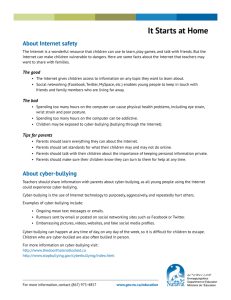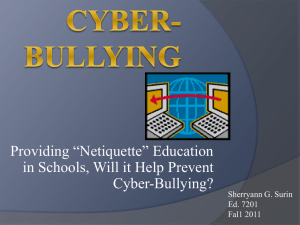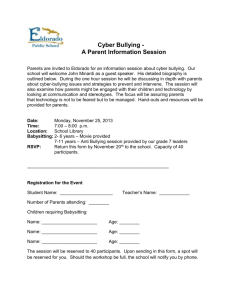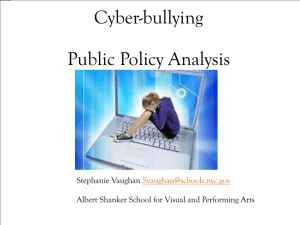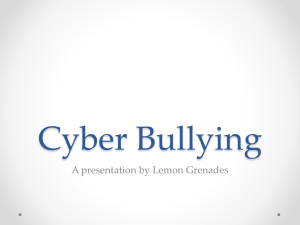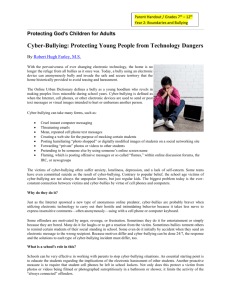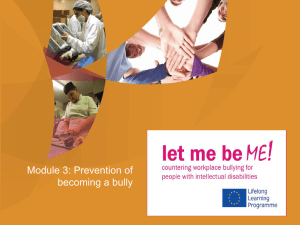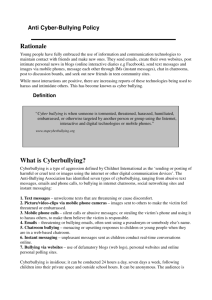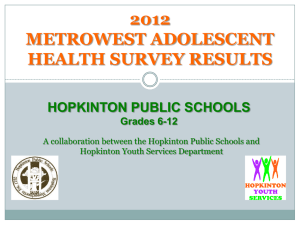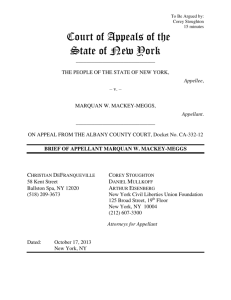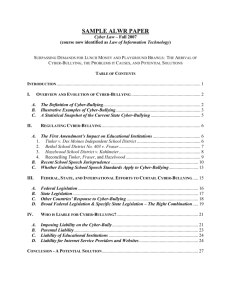Negative and Positive Effects - SL5040
advertisement
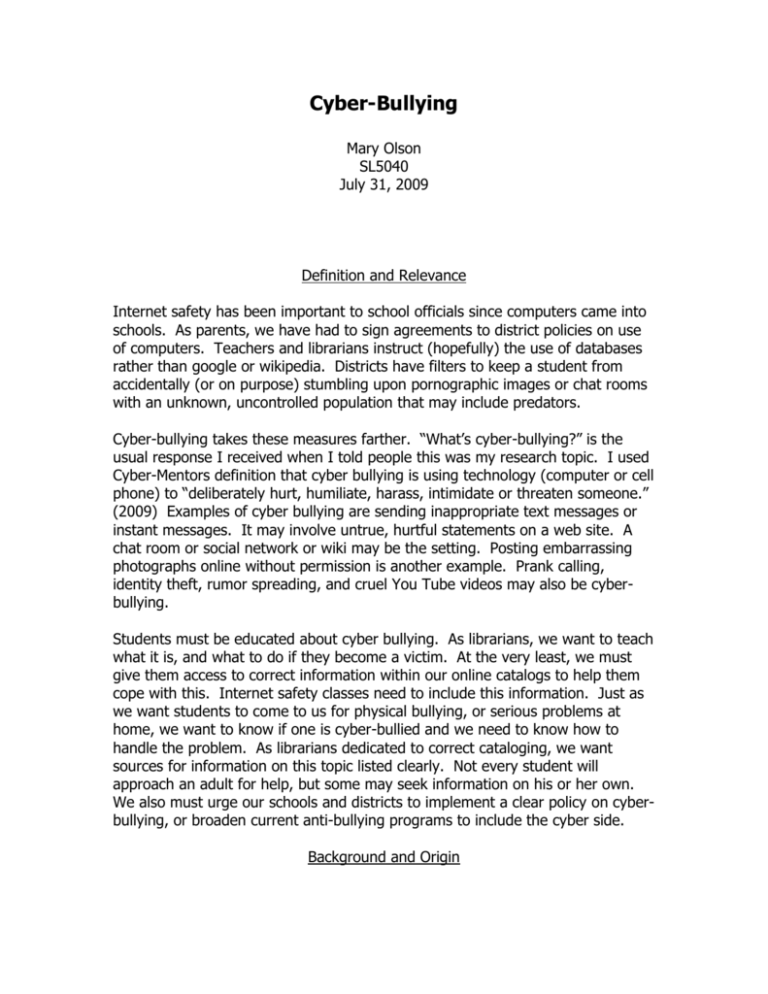
Cyber-Bullying Mary Olson SL5040 July 31, 2009 Definition and Relevance Internet safety has been important to school officials since computers came into schools. As parents, we have had to sign agreements to district policies on use of computers. Teachers and librarians instruct (hopefully) the use of databases rather than google or wikipedia. Districts have filters to keep a student from accidentally (or on purpose) stumbling upon pornographic images or chat rooms with an unknown, uncontrolled population that may include predators. Cyber-bullying takes these measures farther. “What’s cyber-bullying?” is the usual response I received when I told people this was my research topic. I used Cyber-Mentors definition that cyber bullying is using technology (computer or cell phone) to “deliberately hurt, humiliate, harass, intimidate or threaten someone.” (2009) Examples of cyber bullying are sending inappropriate text messages or instant messages. It may involve untrue, hurtful statements on a web site. A chat room or social network or wiki may be the setting. Posting embarrassing photographs online without permission is another example. Prank calling, identity theft, rumor spreading, and cruel You Tube videos may also be cyberbullying. Students must be educated about cyber bullying. As librarians, we want to teach what it is, and what to do if they become a victim. At the very least, we must give them access to correct information within our online catalogs to help them cope with this. Internet safety classes need to include this information. Just as we want students to come to us for physical bullying, or serious problems at home, we want to know if one is cyber-bullied and we need to know how to handle the problem. As librarians dedicated to correct cataloging, we want sources for information on this topic listed clearly. Not every student will approach an adult for help, but some may seek information on his or her own. We also must urge our schools and districts to implement a clear policy on cyberbullying, or broaden current anti-bullying programs to include the cyber side. Background and Origin Megan Meier was a thirteen year-old girl in St. Louis in 2006. She loved her online boyfriend. The trouble began when he started writing ugly, obscene and cruel messages to her. She committed suicide. The boyfriend turned out to be the mother of another girl at Megan’s school. She posed as a boyfriend, to see if Megan was saying any negative things about her own daughter. She laughed when she heard of Megan’s fate. The county discovered this crime did not fit into any category of law already on the books, and that the mother could not be charged. Finally, the federal government filed charges against her in LA, where MySpace (the vehicle for the abuse) is located. They charged her for committing fraud for masquerading as Megan’s boyfriend. The case is not yet decided. This mother will likely have a hefty fine and some prison time. The difficulty in charging her was the impetus for many states to pass laws against this type of abuse. In fact, a new act, the Megan Meier Cyberbullying Act is pending in Congress. But it is too late for Megan. (The Economist, 2009). Senator Robert Menendes introduced a bill to Congress in May, 2009. It would provide funding to programs and grants that educate children in safe, ethical technology use (Kremen, 2009). He named the bill AWARE (adolescent web awareness requires education). This bill goes beyond a 2008 bill which instructed educators to teach internet safety, but provided neither funding nor training for teachers. (Internet Wire, 2009). Negative and Positive Effects The negative effects of cyber-bullying are vast and as devastating as face to face bullying. Hearing of Megan’s plight and the cruelty of the mother, Mrs. Drew, is tragic. The Columbine High School shootings leap immediately to mind as the extreme response of two bullied victims. I spoke with a teenager who had been the victim of cyber-bullying. As is sadly typical, a girl who had been her friend began to spread rumors around the school to other students and even teachers. Numerous cruel text messages were received. Finally this girl dropped out of an activity she had been part of for a couple years to diminish contact with this girl. This seemed to end the abuse. Another type of cyber bullying was experienced by a sixth grader, Piper. A group of girls made a YouTube cartoon video called, “Top Six Ways to Kill Piper.” Not everyone who heard about this incident even had any concern about it. (CNN Newroom, 2009). Technology helps us with so much…research, connections around the world, and innovations. But as educators, we must learn to teach students how to use technology in a smart way. Fourteen technology companies such as Google, MySpace and Facebook have united to combat cyber-bullying. They are creating an online resource to help educate teachers and brainstorm ways of using mobile phones as part of learning in the classroom. (Cooper, 2008) The response to cyber-bullying is enormous. The number of web sites that are geared to parents, teachers, teens and tweens awed me. Cybermentors.org.uk is one of many web sites that I visited. To my mind, this is the best of the bunch. It is all encompassing. Eleven tips are suggested to prevent and to handle cyber-bullying. The first tip is to report cyber-bullying. Cybermentors is available to hear about abuse and has a team of former victims-turned counselors to work with effected individuals. Not responding or retaliating is important. Saving the evidence is recommended, so there is a record of what has happened and when. Be careful with the information you give out online. It should be as general as possible (no address, phone numbers especially). (Cybermentors). Action Steps Besides being aware of the problem of cyber-bullying, teachers and librarians need tools to instruct and help students. Here is a short list of great web sites that have that information and help. These would all be great to put on a Delicious account, or bookmark as favorites. Here is a list of sites I found with helpful information about cyber-bullying This is a hotline for cyber stalking, bullying and abuse. It has current relevant news articles, and links to safe social networks, legal advice, information for librarians. They have free online videos to help instruct students. www.wiredforsafety.org This site is geared toward the adult audience. It includes research, policy and news reports. It lists 10 steps for families to halt cyber-bullying. www.fightcrime.org/cyberbullying Both parent and kids pages are available. There are games and webisodes for students. The parent pages inform on cyber-bullying, a catalog of resources, law enforcement, educators and advisors. www.stopbullying.now.hrsa.gov This site has pages for the community, parents and students. There are interactive games, videos, and current facts and statistics on Internet safety. www.webwisekids.org Sponsored by the Center for Missing & Exploited Children, this site targets parents, educators, law enforcers, teens and younger kids. It has excellent videos, (see tracking Teresa) and includes the viewpoint of the unintended perpetrator of cyber-bullying. www.netsmartz.org A site directed at parents, getnetwise includes a glossary (for those parents not technologically savvy), blog posts, how-to videos, and safe family sites. www.getnewise.org This is another parent oriented site with links for home, educators, higher education, small businesses and tools and resources. The Tools and Resources link had free lesson plans for teachers on ethics and safety topics. www.staysafeonline.org If you search the site for cyber-bullying, there are a multitude of links, including a Frontline episode on Growing Up Online. www.PBS.org http://couros.wikispaces.com/cyberbulling This site includes videos, discussions and resources. This site has helpful definitions, FAQ, articles, warning signs for parents to look for, how to minimize the chance a child becomes a victim, and what to do if it happens. www.FBI.gov/publications/pguide/pgguidee.htm The parents’ page has nothing on internet safety. The Kids’ page has at least 90 articles. The Teens’ page has a section of hot topics, which include articles written by teens. There are more links to Internet safety. www.kidshealth.org Personal Impact The volume of available resources on cyber-bullying amazed me. I had no idea how widespread cyber-bullying is (West, 2009) or the negative effects it can have on a person. Instead of feeling complacent about Internet safety, I have developed a desire to instruct kids on the dangers of cyber-bullying. I was encouraged by the wealth of knowledge available on the topic of Internet safety and cyber-bullying. References Cooper,W. (2008, April 3). Online giants unite to combat cyber-bullying. In The New Media Age, p. 2. Retrieved July 20, 2009 from nma.co.uk. www.nma.co.uk Cyberbullying. Retrieved July 21, 2009 from TheSite.org: http://www.thesite.org/homelawandmoney/law/victims/cyberbullying Cyber-bullying on a whole new level. (Broadcast transcript). (2009, May 25). Retrieved on July 21, 2009 from General Reference Center Gold via Gale: http://find.galegroup.com.ezproxy.denverlibrary.org:2048/itx/start.do?pro dId=GRGM Kremen, M. (2009, April 25). Menendez pushes cyber safety bill; seeks to help teens shun bullying, sexual messages. In The Record (Bergen County, NJ). Retrieved July 20, 2009, from General Reference Center Gold via Gale: http://find.galegroup.com.ezproxy.denveribrary.org:2048/itx/start.do?prod Id=GRGM Megan’s Law; Cyber-bullying and the courts. (2009, July 19). In The Economist (US), 392.8639. Retrieved July 20, 2009, from Gale General Reference Center: http://gind.galegroup.comezproxy.denverlibrary.org:2048/itx/start.do?pro did=GRGM Middleton, A. (2009, June 3). Cyber-bullying to be included in schools’ policy. In Europe Intelligence Wire. Retrieved July 20, 2009, from General Reference Center Gold via Gale. Denver Public Library: http://find.galegroup.com.ezproxy.denverlibrary.org:2048/itx/start.do?pro dId=GRGM Raimes, A. (2005). Keys for Writers. Boston: Houghton Mifflin. Tonn, J. (2006, August 30). Cyber bullying. In Education Week, Vol. 2 Issue 1, p.19-19, 1/9p. Retrieved July 20, 2009, from MasterFILE Premier: http://web.ebscohost.com.ezproxy.denverpubliclibrary.org.2048/ehost/det ail?vid=1&hid=3&sid= Top tips on cyberbullying! Retrieved July 20, 2009. http://cybermentors.org.uk/index.php?option+com_content&task=view&i d=683&Itemid=169 Web wise kids applauds house introduction of historic child Internet safety legislation: bill would provide funding to programs educating children and teens on safely using the Internet and mobile technologies. (2009, July 16). In Internet Wire. Retrieved July 20, 2009 from General OneFile via Gale via Denver Public Library: http://find.galegroup.com.ezproxy.denverlibrary.org:2048/itx/start.do?pro dId=ITOF West, P. (2009, June 29). Cyber bullying affects one in 10 students. In Consumer Health News (English). Retrieved July 20, 2009, from General Reference Center Gold via Gale: http://find.galegroup.com.ezproxy.denverpubliclibrary.org:2048/itx/help/h elpTopics.html What is cyberbullying? Retrieved July 20, 2009. (http://cybermentors.org.uk/index.php?option+com_content&task=view&i d=683&Itemid=169)
